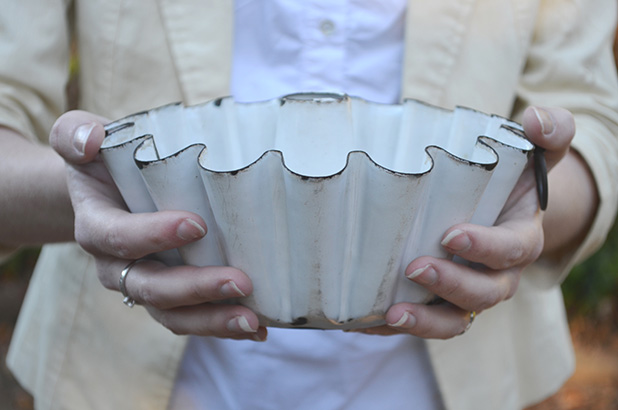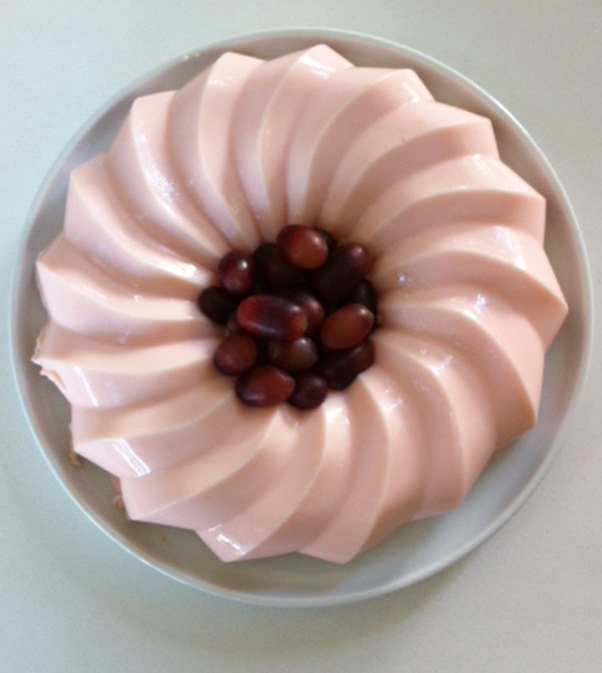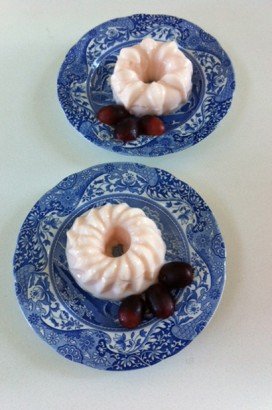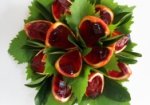Our ‘Marching on’ post included an introductory video for Rouse Hill House and Farm and its rich food heritage. In it we talk about blancmange, a chilled milk-based dessert dish that Nina Rouse used to make for her children and later, her grandchildren. Nina’s granddaughter Miriam Hamilton has fond childhood memories of pink blancmange being made in a fluted enamel mould, which still remains in the Rouse Hill house collection today. In hot weather, if there was no ice available, Nina would suspend the blancmange in the house’s cistern to allow the pudding to set.
Kitchen alchemy
The subject of blancmange, and the description I gave for it in the video, as a gelatine based milk pudding, sparked debate with one of our regular readers, Alison. Alison was surprised at the use of gelatine in blancmange, when isinglass, a fish-based gelling agent was tradtionally used. But stepping forward another generation or three, Alison recalls her mother making blancmanges with cornflour rather than gelatine. Alison’s comment caused me a moment of panic and self-doubt (no-one likes being caught out giving misinformation on film!) and prompted me to investigate blancmanges more thoroughly.
Ancient origins
Blancmange, of course, should be white as in French blanc; mange or manger, French for eat or food, suggests ‘edible white’ or ‘to eat white food‘. There is a long history for white food, revolving around purity, usually linked with royalty and religion which I won’t go into now. But it is interesting to track the evolution a dish, and while I’m sure others have written about it far more depth, my understanding is that blancmange origins lie in ancient Middle Eastern or Persian cuisine where it was refined savoury dish of chicken, almond-milk and egg whites flavoured with rosewater and a little sugar.
As tastes and techniques travel about the globe with trade, migration or cross-cultural communication, traditional dishes alter to adapt to new locales, with ingredients being substituted to suit local tastes, available produce and technologies. Blancmangle appears in an late C16th English cookery book, with capon brains, almonds, egg whites and cream. But over time the chicken and egg disappeared and as sugar became cheaper, it became a dessert dish, sometimes thickened with rice, which would probably be closer to what the English call a flummery. Possibly responding to a more northern European influence that favoured dairy over almond milk, blancmange turned into a dairy-milk pudding flavoured with bitter or sweet almonds in the C18th, then the almonds almost invariably disappear as a characteristic ingredient in the 19th century. Continuing to evolve, gelatine replaces isinglass in the late C19th and early 20th, and cornflour enters the fray around the same time, and by late C20th blancmange is but a memory, or indeed a complete mystery, for most of us.
So essentially, blancmange is a delicately flavoured milk pudding that holds its form, even if the source of the milk varies and the science behind setting or congealing it changes with time.
A recipe timeline
Historic cook books provide a reasonable chronology albeit a random selection of texts: Raffald (1769) bases hers on calf’s feet jelly (home made gelatine) but still calls for bitter almonds; Acton (1845), Beeton (1861 & c1902) and Cassell’s (c1890) all ask for isinglass. Isinglass produced a fine, crystal clear gel (it is still used to clarify some wines), but by the end of the C19th century it had given way to the relatively new and convenient ‘instant’ or dried gelatine that emerged with new processing technologies, and many recipes that used isinglass were re-written in gelatine’s favour. Beeton also includes an ‘Arrowroot blancmange’ , a precursor to cornflour blancmange. The Kookaburra cookbook (1912), The Goulburn and The Golden Wattle cookery books (post 1930) all use gelatine. Interestingly the Kookaburra Cookery book recipe is enriched with eggs, rendering it, in the purists’ eyes, a custard pudding rather than a blancmange; the Golden Wattle also includes a ‘Cornflour mould’ which is almost identical to The Commonsense Cookery Book (1914 – 2014 editions) balncmange. The wash-up from all this they are essentially, variations on a sweetened milk pudding with a flavouring of some kind – rose or blossom water, laurel or bay leaves, lemon peel, ‘essence’ – almond or vanilla perhaps. Several recipes instruct that you stand the blancmange mould in a shallow basin of iced or cold water until it sets – the coldest water Nina did knew of on a hot summer’s day was a few metres below ground in the well.
A clever marketing exercise
Cornflour is not commonly seen in C18th and C19th British cookbooks – you’d find ‘Indian’ corn (referring to its American origins) for polenta-like cornmeal puddings, but until the mid C19th what we know as cornflour was mainly used as a laundry product, used to stiffen aprons, shirt colours and cuffs. Rather than being a milled flour per se, cornflour is actually cornstarch, extracted from the germ and endosperm of the maize kernel, dried and processed into a fine powder. Household management books such as Mrs Beeton’s include receipts for the laundress, for the formula to convert the cornstarch into an early version of ironing spray. And today, cornstarch is used as an alternative to talcum powder.
Traditionally, ground rice, arrowroot or tapioca flour were commonly used to thicken dessert puddings, soups and stews and although cornstarch was identified as a food-thickening agent from the 1830s (for eggless custard), it wasn’t really until the late 1800s that it gained hegemony in the domestic kitchen. The turn of the century saw a proliferation of advertisements for cornflour in cookbooks, magazines and grocers catalogues and the traditional thickeners found themselves gradually becoming obsolete. This is a good example of the way that foods alter and evolve with technology and taste, industrialisation and marketing.
What’s in a name?
We still buy cornflour based custard powders (basically sweetened, coloured cornflour) but blancmange powders which were sold in my grandmother’s day have long disappeared. While the cornflour blancmange recipe has survived in The Commonsense Cookery book, blancmanges seem to have slipped from our modern dessert repertoire. The gelatine based blancmange is still with us to some degree, in the richer and more appealingly named Italian panna cotta which uses cream rather than milk, vanilla or other flavouring, and set with gelatine.
And Nina’s pink blancmange? Fruit was added to the isinglass blancmanges in the C19th, and the Rouse’s copy of Warne’s Model Cookery features strawberry blancmange, but as Eliza Acton points out – a strawberry or pink blancmange is, of course, an argument in terms, as it is not white. She suggests it should instead be called a ‘moulded strawberry cream’ or a bavarois ‘Bavarian cream’ such as we might make these days, fruit puree and cream set with gelatine.
Putting it to the test
After all this discussion I decided it was time to road test a couple of blancmange recipes to see why they have dropped off the modern menu – is it simply because they’re regarded as the ‘poor cousin’ to the richer, more stylish panna cotta or bavarois? Or because they became so generic, losing so much of their original mystique, as jelly has, with all the instant shortcuts that have come with technology and industrialised food? Or is it that we can so easily buy ice cream and chilled desserts there’s just no need for home made milk puddings? Nina and her husband ran a dairy at Rouse Hill so enjoyed their own fresh milk, which was probably much richer than the highly processed milk we buy today – its likely that her blancmange was richer and creamier than one we would make today.
Both blancmanges turned out surprisingly successfully – and with the help of silicone moulds, ‘turned out’ surprisingly easily! (memories of our Alien jelly disaster still echo in my mind).
Blancmange made with cornflour
Ingredients
- 2 tablespoons cornflour
- 2 cups milk
- 1 heaped tablespoon sugar (or to taste)
- 1 bay leaf or slice of lemon peel
- 3 drops essence - vanilla, rosewater, lemon
- colouring (optional)
- fresh fruit or jelly, to serve
Note
This recipe is adapted from The Commonsense Cookery book, 1961 edition. It suggested using a peach leaf for flavour, which is a rather nice touch, but I didn't have one to hand to try out. The 2014 Centenary edition has a modern variation, with more milk and less sugar, and the peach leaf is lost to history. The bay leaf introduces a subtle and interesting hint of flavour, which you might want to try for a change.
Directions
| Blend the cornflour with 1/4 cup of the milk in a small dish or cup. Heat the remaining milk in a small saucepan with the sugar, bay leaf or piece of lemon rind. When it is almost at a boil, remove pan from the heat, remove leaf or peel, stir in the blended cornflour and stir well. Return to the heat and bring to the boil, reduce heat to a steady simmer and cook for three minutes, stirring. Add essence and colouring, if using. | |
| Rinse a mould in cold water, shake off excess water but leaving it quite wet, pour mixture into the mould. Refrigerate until set. When ready to serve,loosen around the edge of the mould, invert mould over a serving plate and allow the balncmange to slip from mould. Serve surrounded with fresh fruit or colourful jelly. | |
| Cook's tip: you may have to place a warm damp cloth over the mould for half a minute or so to help the bakncmange to release cleanly. Silicon moulds are much easier to release than traditional metal, glass or ceramic | |
Blancmange made with gelatine
Ingredients
- 2 teaspoons gelatine
- 600ml milk
- 1 heaped tablespoon sugar (or to taste)
- 1 strip of lemon rind
- flavouring - vanilla, rosewater (optional)
Note
This blancmange recipe comes from The Golden Wattle cookery book, first published in the 1920s and still in print today. The flavouring is optional, but masks the taste of the gelatine. Rosewater is nice in a pink blancmange, vanilla or lemon essence in a white one.
Directions
| Soften gelatine in 1/4 cup of cold water and set aside. Heat milk, sugar, lemon rind and flavouring in a saucepan until it just begins to boil, stirring to dissolve the sugar. Remove from heat, add gelatine and stir to dissolve completely. Wet a mould with cold water, shaking off any excess and fill with the blancmange mixture. Refrigerate until set. | |
| When ready to serve, invert mould onto a serving plate and allow blancmange to release itself from the mould. You may need to wrap a warm damp teatowel around the mould for half a minute or so to relinquish the contents. | |



 Print recipe
Print recipe

